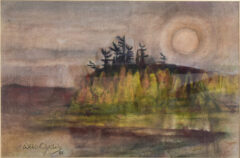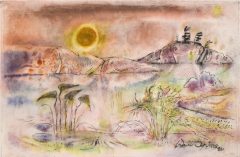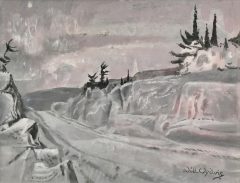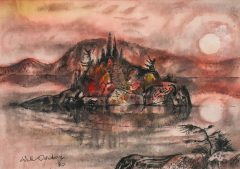Will Ogilvie
Read more... View selected works...
OGILVIE, William Abernethy
Born at Stutterheim, Cape Province, South Africa, the son of Walter and Bertha (Frachét) Ogilvie, he attended public school at Stutterheim (1910-14) then Queen’s College, Queenstown, Cape Province (1915-20) where he graduated with his Senior Matriculation. He took art training with Erich Mayer at Johannesburg (1921-24). He came to Canada in September of 1925 and settled for a time in Toronto then went to New York City where he studied at the Art Students’ League (1928-30) under Kimon Nicoliades. He visited South Africa in 1931 and painted a number of scenes which were later exhibited in important group shows. He worked for a short time as a commercial artist in New York gaining valuable experience for future use. He returned to Toronto at the time of the Depression.
In 1932 he teamed up with Charles Comfort and Harold Ayres. They opened an office in Toronto and accepted a variety of commissions from portraiture to advertising layout, architectural decoration to magazine illustration and their firm survived because of the collective diversity of the partners. During the summers each of them had time to develop his own art. Ogilvie did a number of figure studies which he continued to do throughout his career. Jerrold Morris in his book The Nude in Canadian Painting draws to the reader’s attention influences like the arabesque in Art Nouveau and the geometry of abstract art which he sees in the artist’s nude studies.
In 1936 Ogilvie was commissioned by the Massey Foundation to do murals for the Chapel of Hart House, University of Toronto. Viewing the completed work, critic Graham McInnes writing in Saturday Night noted, “Taking his inspiration partly from the Primitive Italian altar pieces, partly from the formal aspects of the Canadian landscape, and fusing them with his own delicate imaginative quality, Mr. Ogilvie has produced a work whose easy rhythmic flow, and soft cool tones, combine to give an atmosphere of contemplative and austere spirituality. This reaches its height in the main panel on the south wall, in which a refreshingly new treatment of the Madonna and Child motif makes a central group of exquisite charm.” A further description was given by Josephine Hambleton in The Ottawa Citizen as follows, “Two white doves flutter joyously about the Madonna of the mural. The mother inclines her head tenderly over her solemn Child. He sits on her knee, back straight, hands clutching a white trillium and he stares before him, as though he perceived all the crimes and all the wars throughout history. A bank of white trilliums stretches behind Jesus and Mary, and before them, kneel a Canadian family, the man, clean-shaven, the woman, holding a white trillium, and their little girl. The beasts pay the Redeemer homage too, a shy, proud deer and her speckled fawn and the Heavenly Hosts are men and women of our own age and clime, lifted by religious exaltation from their round of pleasure and of pain, of charity and of crime, of temptation and of repentence, into the dwelling-place of God.” Shortly after its completion the Hart House mural was the subject of articles in Saturday Night, Bertram Brooker’s Year Book of The Art (1936), and The Studio (No. 533, 1937).
While Ogilvie was working in conjunction with the two other artists he continued with his own painting exhibiting with the Canadian Society of Painters in Water Colour (member, 1934) and the Canadian Group of Painters (Founding Member, 1933). A.H. Robson in his book Canadian Landscape Painters (1932) noted Ogilvie’s work as having “Subtlety and refinement in colour and a delightful sense of design” but noted that the artist’s attentions were on his figure painting more than his landscapes. But Ogilvie has always been able to include both figures and landscapes in much of his work and a popular example of this can be found in his numerous war paintings. The opportunity to teach at the School of Art at the Art Association of Montreal brought his partnership with Comfort and Ayres to an end. Comfort went to the Ontario College of Art to teach mural painting, but we are not told what path Ayres followed.
At the Art Association (1938-41) Ogilvie gave lectures, taught life drawing, also painting and composition and also assumed the additional responsibilities as Director of the School during his last two years in Montreal. He joined the Canadian Army in 1940 and after basic training was employed as a service artist at CMHQ, London, England, then he was commissioned in 1942 as an Official War Artist. He became senior army artist overseas with a final promotion to Major later on in the war. He painted a variety of scenes in the United Kingdom including AA defences on the Thames estuary, Forestry Corps camps, and invasion training in Scotland. Then he was dispatched to the battle zones in Sicily and Italy and in North-West Europe.
Viewing his sketches of the Falaise Gap in France, Josephine Hambleton writing in The Ottawa Citizen noted, “Pen and ink lines indicated contours, watercolour washes, the shadows. They conveyed the feeling war had drawn all life to an irrevocable close. The fears, the hopes they had felt a few moments before, the fatigue they had borne, and courage they had shown, could never matter again to the dead soldiers . . . these sketches are in every line, in every tone, alive and horrifying, because their creator made them while he himself was deafened by explosions, blinding gun-fire, and spent days among the dead, days battle robbed of dawn and twilight.”
Ogilvie was awarded the M.B.E. (Military) for his service as a war artist. His war paintings are deposited in the collection of the Canadian War Museum, Ottawa. After discharge from the Army he returned to teaching and painting at the Banff School of Fine Art (summer, 1946); Ontario College of Art (1947-57); Queen’s University School of Fine Art (summer, 1947); Mount Allison University (summer, 1958). He received a Canadian Government Overseas Royal Society Fellowship to study in Italy (1957-58). About this time he joined a geophysical expedition from the University of Toronto during International Geophysical Year, to witness the scientists measure and map the Salmon Glacier on the border of B.C. and Alaska. Ogilvie sketched and painted the huge icefield, the mountains, the peculiar rock formations and the colourful flora in the area then returned to his studio in Toronto. In September of that same year these paintings were exhibited at the Hart House art gallery coinciding with the assembly of the International Union of Geodesy and Geophysics held at the University of Toronto. He continued to exhibit with the Canadian Society of Painters in Water Colour and the Canadian Group of Painters. He made return trips to South Africa, Mexico, and in Canada he recorded his impressions of Georgian Bay and areas of Southern Ontario.
He was commissioned to design a window to commemorate Hart House’s 50th Anniversary and the window was dedicated to Vincent Massey. Good reproduction of Ogilvie’s paintings can be found in Elizabeth Kilbourn’s Great Canadian Painting (1966, P. 47) and Paul Duval’s Four Decades (1972, P. 130). Since 1960 he has been special lecturer in Historical Techniques of Painting at the University of Toronto. His one-man shows include the following: Picture Loan Society, Toronto (annually 1934-66); Gainsborough Galleries, Johannesburg, South Africa (1954); Hart House, U. of T. (1957, 1962); Adler Fielding Gallery, Johannesburg (1963); Victoria College, U. of T. (1964); Wells Gallery, Ottawa (1966, 1967); Fleet Gallery, Winnipeg, Man. (1966); Roberts Gallery, Tor. (1967, 1969, 1971, -).
Over the years he has exhibited in many group shows national and international and the very first exhibition of the Canadian Group of Painters in Atlantic City, NJ. (1933); South Dominions (1936); Tate Gallery, Lond., Eng. (1938); World’s Fair (1939); Brussels, War Art (1944); NGC, Ottawa, War Art (1945-46); Rio de Janiero (1946); U.N.E.S.C.O. (1946); The Fourth Biennial Exhibition of Canadian Art (1961). Paul Duval notes in his Four Decades that Ogilvie holds a significant place in the writing of the history of mid-century Canadian art for his work in water colours. He is represented in the following collections: Edmonton Art Gallery, Alta.; Art Gallery of Winnipeg, Man.; Sarnia Art Gallery, Ont.; London Public Library and Art Museum, Ont.; Art Gallery of Hamilton, Ont.; Art Gallery of Ontario, Tor.; Hart House, Univ. Tor.; National Gallery of Canada, Ott.; Canadian War Museums, Ott. and in many private collections. He lives in Palgrave (Albion Hills) Ontario with his wife Sheelah.
Colin S. MacDonald
A Dictionary of Canadian Artists, volumes 1-8 by Colin S. MacDonald, and volume 9 (online only), by Anne Newlands and Judith Parker
National Gallery of Canada / Musée des beaux-arts du Canada
Johannesburg under Erich Mayer
Art Students League, New York under Kimon Nicolaides
Official Canadian War Artist, Awarded the M.B.E. (Mil.)
Canadian Government Overseas Royal Society Fellowship
Member, Order of Canada - 1979
Director, School of Fine Art, M.M.F.A. - 1940-41
Summer Instructor, Queen's University - 1947
Instructor, Ontario College of Art - 1947-57
Instructor, University of Toronto - 1960
Royal Canadian Academy
The Canadian Group of Painters
The Canadian Society of Painters in Water Colour
Mural for Hart House, U. of T., 1936
South Dominions, 1936
Tate Gallery, England, 1938
World's Fair, 1939
Goucester, England, 1939
Picture Loan Society, Toronto, 1934-66
Brussels, War Art, 1944
National Gallery of Canada War Art, 1945-6
Rio de Janiero, 1946
UNESCO, 1946
Gainsborough Galleries, Johannesburg, 1954
Hart House, U. of T., 1957, 1962
Wells Gallery, Ottawa, 1966, 1967
Roberts Gallery, 1967,69,71,73,75,77,79,81,85
National Gallery of Canada
Art Gallery of Ontario
Art Gallery of Hamilton
London Regional Art Gallery
Winnipeg Art Gallery
Edmonton Art Gallery
Sarnia Public Art Gallery
Hart House, U. of T.
Tom Thomson Memorial Gallery
Royal Collection - Library, Windsor Castle
numerous private collections across Canada




